
Prepare to be mesmerized by a riot of color, a flourish of fringed petals, and a garden transformed into a vibrant paradise. Step into the world of parrot tulips, where nature’s artists paint their masterpieces with bold strokes and intricate patterns. Get ready to unleash your inner gardener and embark on a journey filled with beauty, drama, and a touch of whimsy. Brace yourself for a mesmerizing spectacle as we delve into the secrets of cultivating these fascinating blooms. Welcome to the enchanting realm of growing parrot tulips, where every petal tells a story and your garden becomes a living canvas. Keep reading to discover the top five parrot tulips for your garden and how to keep them vibrant.

©DeepGreen/Shutterstock.com
What Are Parrot Tulips?
Parrot tulips are a variety of tulips known for their vibrant and flamboyant blooms. They are highly popular among gardeners and flower enthusiasts for their striking colors, intricate patterns, and distinctive petal shapes. Additionally, parrot tulips belong to the genus Tulipa of the Liliaceae family.
What sets parrot tulips apart from other tulip varieties is their ruffled and fringed petals. The petals have irregular edges, creating a textured appearance that resembles the feathers of a parrot, hence the name.
The petals come in a wide range of colors, including shades of red, yellow, pink, purple, and also white. Some parrot tulip varieties even exhibit color combinations, streaks, or flames, which further enhance their visual appeal.
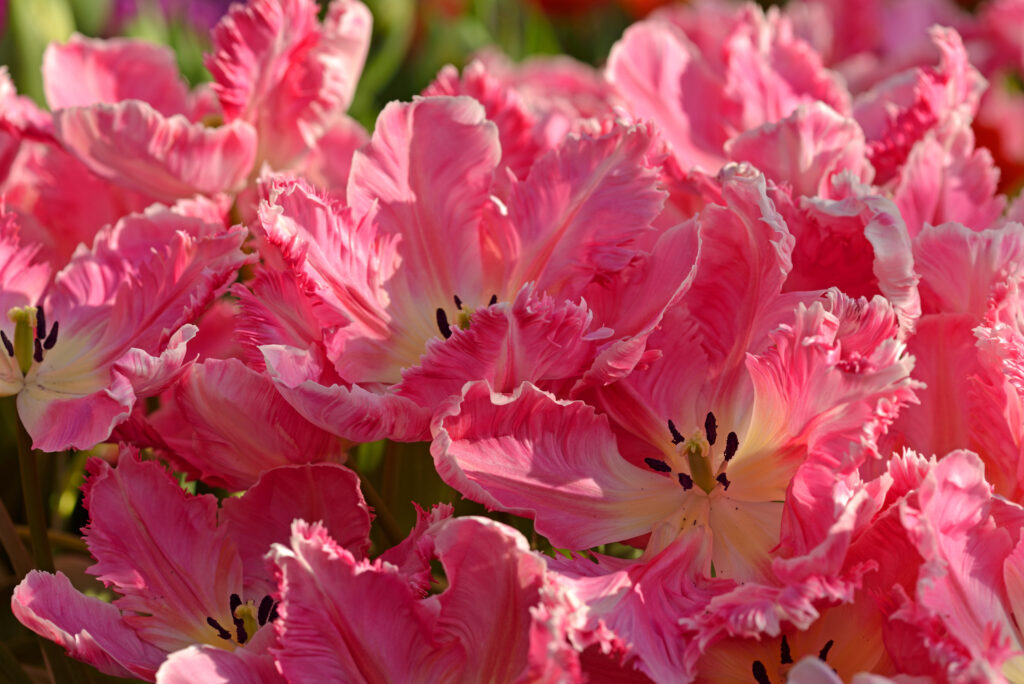
©Popova Valeriya/Shutterstock.com
In addition to their unusual petal structure, parrot tulips are known for their large-sized blooms. The flowers are generally larger than those of standard tulips, adding to their dramatic and showy appearance. The sturdy stems of parrot tulips can reach heights of up to 24 inches (60 cm), providing a strong base for the large and heavy blooms. However, the stems are no match for spring winds and may require staking to remain standing tall.
Parrot tulips are typically grown from bulbs, which are planted in the fall for spring flowering. They require a period of cold dormancy to promote proper growth and flowering. These tulips prefer well-drained soil and a sunny location to thrive. Adequate sunlight is essential for the development of their vibrant colors and sturdy stems.
Parrot tulips are commonly used in flower arrangements and floral displays due to their eye-catching blooms. They add a touch of drama and elegance to bouquets and can be combined with other tulip varieties or complementary flowers to create stunning arrangements.
Destiny
The destiny parrot tulip, formerly Estella Rijnveld, is adored for its striking and vibrant blooms. It showcases a winning combination of red and white colors in its petals. The petals have a unique and eye-catching pattern, with red flames or streaks running along the white background. This striking coloration and pattern create a dramatic and dynamic visual display, therefore, making the destiny parrot tulip a standout in any garden or floral arrangement.
Similar to other parrot tulips, the destiny parrot tulip features ruffled and fringed petals that resemble the feathers of a parrot. The petals have irregular edges, adding a touch of texture and also depth to the blooms. The flowers are medium to large in size and are held atop sturdy stems, which can reach heights of up to 20 inches (50 cm).
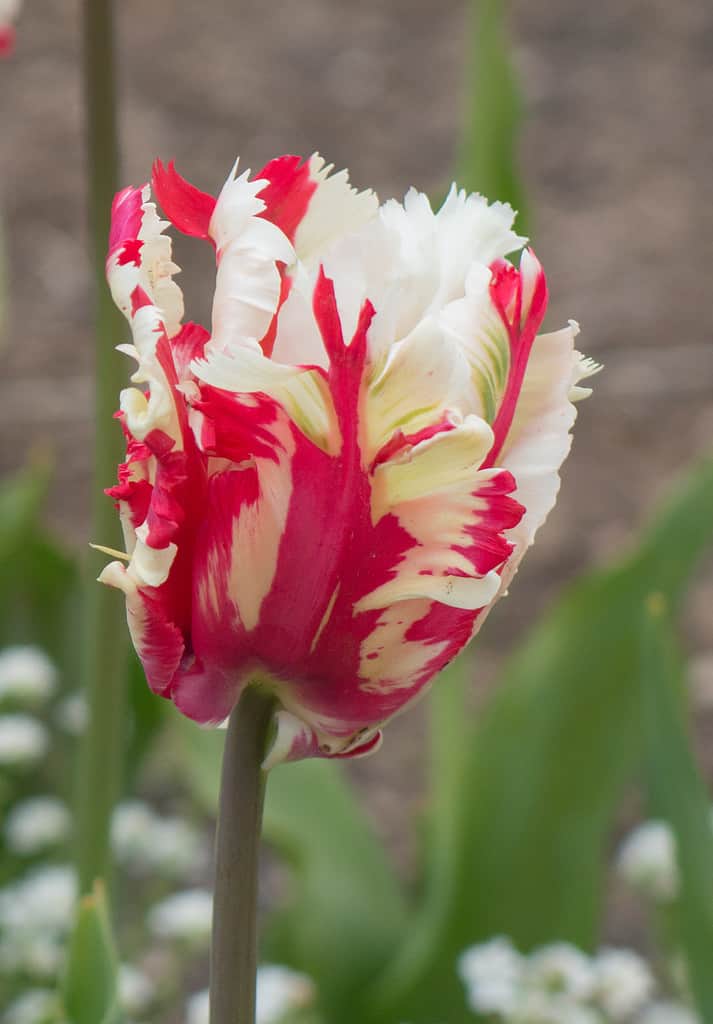
©Peter Turner Photography/Shutterstock.com
Flaming
The flaming parrot tulip is a stunning variety of parrot tulips known for its vibrant and fiery-colored blooms. It is a colorful and eye-catching flower that adds a touch of drama and excitement to gardens and floral arrangements.
The flaming parrot tulip displays a remarkable color combination of red and yellow hues. The petals often have a flame-like appearance, with vibrant streaks or splashes of color that resemble flickering flames. The intensity and distribution of the colors can vary among different cultivars, but they all contribute to the striking and dynamic nature of the flaming parrot tulip.
Like other parrot tulips, the flaming parrot tulip also features ruffled and fringed petals, giving it a distinctive and textured look. The irregular edges of the petals create a feathery appearance, adding to its visual appeal. The flowers are medium to large in size and are held on sturdy stems, which provide support and structure to the blooms.
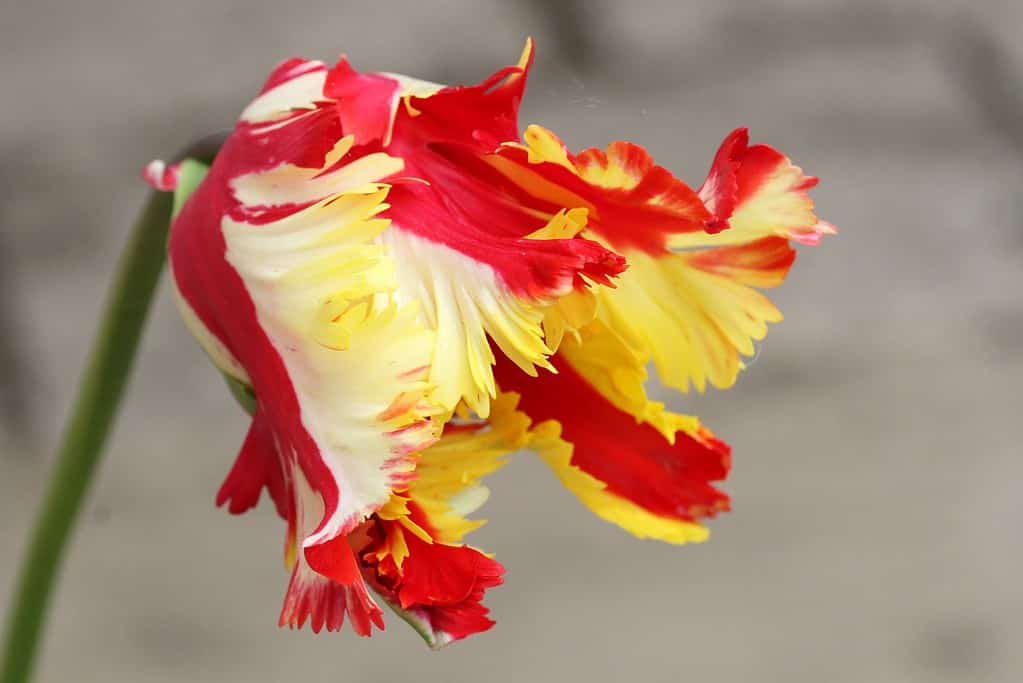
.
©Piaffe Photography/Shutterstock.com
Black
The black parrot tulip is a highly sought-after variety known for its dark, velvety blooms. While it is referred to as black, the petals of this tulip are actually a very deep purple or maroon. In addition, the black parrot tulip showcases large-sized flowers with ruffled and fringed petals.
The edges of the petals have an irregular and feathery appearance, adding texture and depth to the blooms. The dark coloration of the petals creates a dramatic and striking contrast against the surrounding foliage and other flowers, making the black parrot tulip a focal point in any garden or floral arrangement.
The stems of the Black parrot tulip can reach heights of up to 24 inches (60 cm), providing a strong base for the bold and showy blooms. The black parrot tulip is an excellent choice for cut flower arrangements.
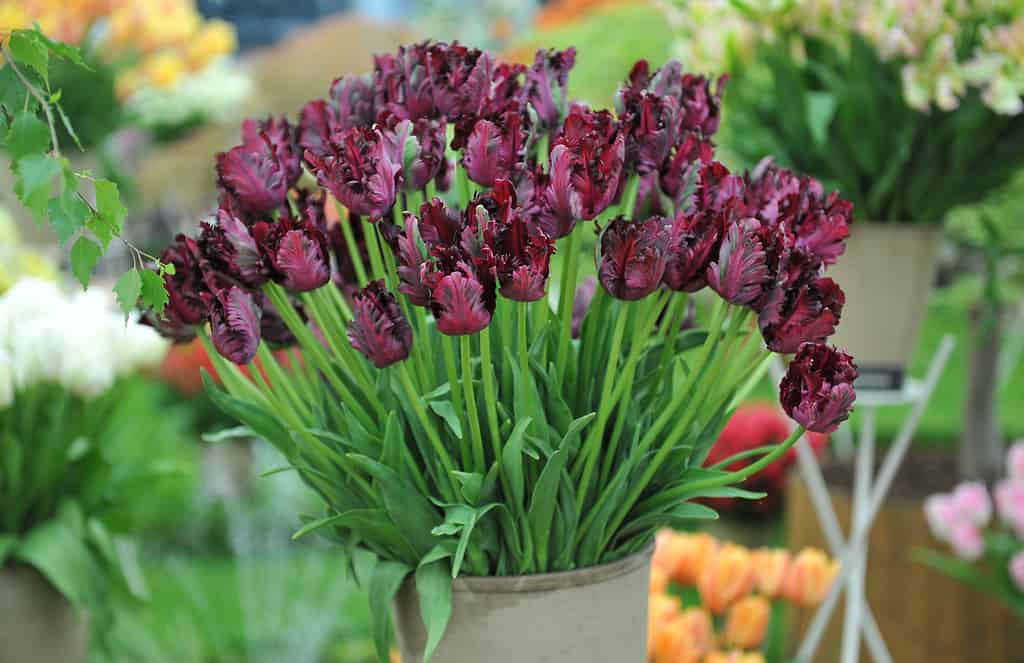
©Sergey V Kalyakin/Shutterstock.com
Apricot
The Apricot Parrot tulip is a stunning variety of parrot tulips renowned for its delicate and beautiful apricot- and-cream colored blooms. This particular tulip variety showcases the distinctive characteristics of parrot tulips, including ruffled and fringed petals. The apricot parrot tulip features large-sized flowers with multiple layers of petals. The petals are intricately shaped, with wavy edges that resemble the feathers of a parrot.
The fringed edges add texture and depth to the blooms, enhancing their visual appeal. The color of the Apricot Parrot tulip ranges from soft peachy tones to deeper apricot shades, creating a warm and inviting presence in gardens and floral arrangements. The blooms of the apricot parrot tulip stand tall on solid stems, reaching heights of up to 24 inches (60 cm). This ensures that the flowers are prominently displayed and can be admired from a distance.
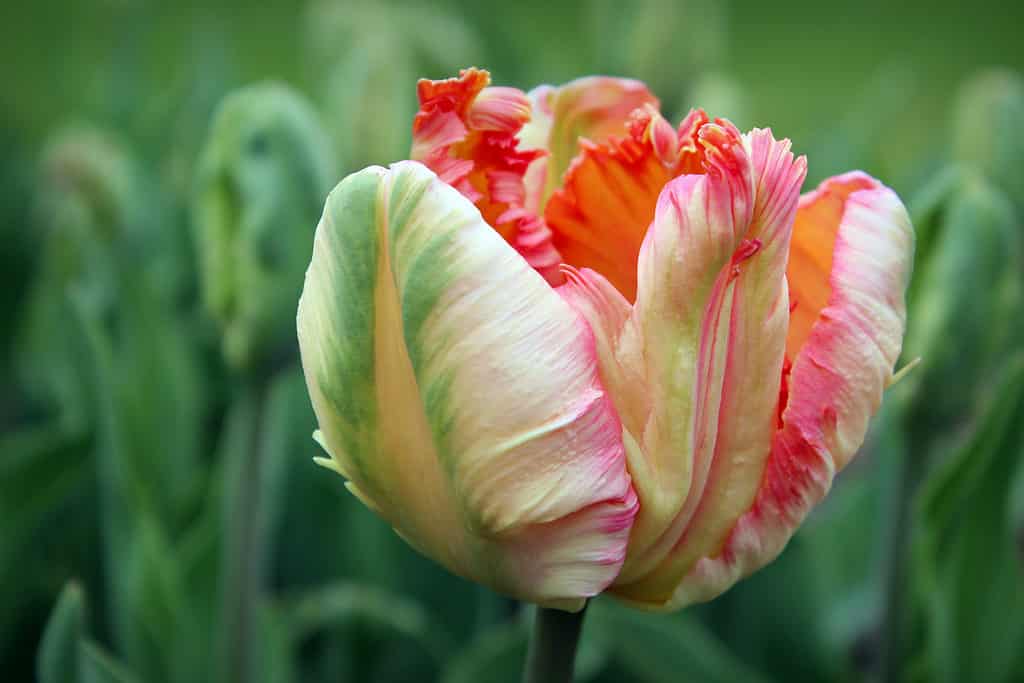
©Joseph Skompski/Shutterstock.com
Silver
The silver parrot tulip is a captivating variety known for its unique and elegant appearance. While parrot tulips typically exhibit vibrant and flamboyant colors, the silver parrot tulip stands out with its stunning silvery-white and red blooms. The petals of the silver parrot tulip have a lustrous sheen. The ruffled and fringed edges of the petals add texture and depth to the blooms, enhancing their overall beauty.
Similar to other parrot tulips, the silver parrot tulip has medium to large-sized blooms that sit atop stocky stems. The height of the stems can reach up to 20 inches (50 cm), providing a strong base for the striking red and white flowers.
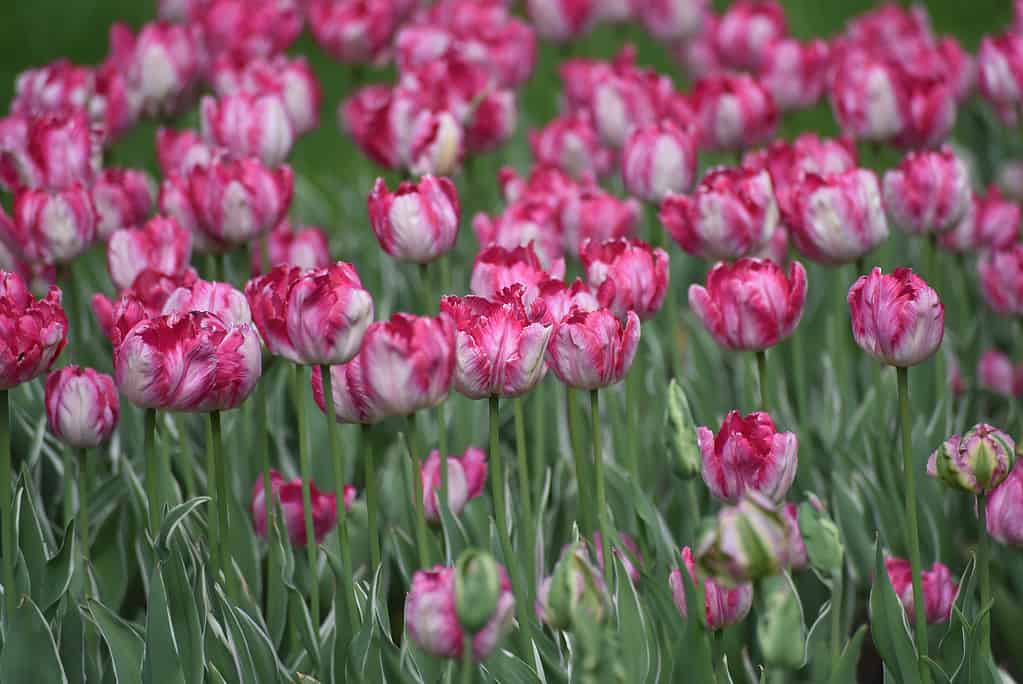
©nshilov/Shutterstock.com
How To Keep Your Parrot Tulips Vibrant
In a Vase
The practice of putting a penny in a vase of parrot tulips to keep them from wilting is a common belief but it lacks scientific evidence to support its effectiveness. While some people claim to have positive experiences with this method, the penny itself does not have any inherent properties that would prevent the parrot tulips from wilting. Several factors contribute to the wilting of cut flowers, including parrot tulips. The most important factors are proper hydration, bacterial growth in the water, and blockage of the stems. By following these steps, you can help extend the vase life of parrot tulips and keep them fresh.
- Clean vase: Start with a clean vase to prevent the growth of bacteria that can clog the stems and hinder water uptake.
- Fresh water: Fill the vase with fresh, room-temperature water. Tulips require hydration to keep their blooms and stem firm.
- Stem trimming: Cut the tulip stems at an angle, about 1-2 inches from the bottom. This allows for better water absorption.
- Remove foliage: Remove any leaves or foliage that would be submerged in the water, as they can promote bacterial growth.
- Water level: Maintain an appropriate water level in the vase, ensuring that the cut ends of the stems are submerged.
- Water quality: Change the water every 1-2 days and rinse the vase to prevent bacterial growth. Some people find success using flower preservatives or floral food that can be added to the water.
- Placement: Keep the vase in a cool location away from direct sunlight and sources of heat, as heat can cause the tulips to wilt more quickly.
In the Garden
To help ensure vibrant and healthy parrot tulips in your garden, select tulip varieties that are known for their vibrant colors and choose bulbs from reputable sources for the best results. Before planting your parrot tulip bulbs, ensure that the soil is well-drained and fertile. Tulips prefer soil with good drainage to prevent bulb rot. You can amend the soil with compost or organic matter.
Plant parrot tulip bulbs in the appropriate depth. As a general guideline, parrot tulip bulbs should be planted 6-8 inches (15-20 cm) deep. Deeper planting protects the bulbs from extreme temperature fluctuations and provides stability. Tulips thrive in full sun to partial shade. Choose a location in your garden that receives at least six hours of direct sunlight each day. Adequate sunlight ensures vibrant flower color and sturdy stem growth.
Watering
While parrot tulips appreciate moist soil, overwatering can cause bulb rot. Water the parrot tulips regularly during the growing season, especially during dry spells. Aim for a consistent level of moisture, keeping the soil slightly damp but not waterlogged. After they have bloomed, refrain from watering the area where the bulbs are planted.
Parrot tulips benefit from a balanced slow-release fertilizer applied in early spring when new growth emerges. Follow the instructions on the fertilizer packaging for proper application rates. After the parrot tulip flowers have faded, remove the spent blooms by snipping them off at the base. Deadheading prevents the plant from putting energy into seed production and encourages bulb development for the following year.
Once the parrot tulips have finished blooming, allow the foliage to wither and turn yellow naturally. This allows the plant to store energy in the bulb for next year’s growth. Avoid cutting back or removing the foliage until it has fully yellowed. Monitor your parrot tulips for pests like aphids or bulb-munching rodents. Take appropriate measures to control pests if necessary.
Every few years, parrot tulip bulbs may become overcrowded and produce smaller flowers. Dig up and divide the bulbs during their dormant season (after the foliage has withered) to rejuvenate them. Replant the bulbs at the appropriate depth and spacing in the fall.
Summary Of The Top 5 Parrot Tulips For Your Garden And How to Keep Them Vibrant
| Rank | Parrot Tulip | How To Keep Vibrant |
|---|---|---|
| 1 | Destiny | Clean vase, fresh water, trim stems, remove foliage, change water, keep in a cool location |
| 2 | Flaming | Clean vase, fresh water, trim stems, remove foliage, change water, keep in a cool location |
| 3 | Black | Clean vase, fresh water, trim stems, remove foliage, change water, keep in a cool location |
| 4 | Apricot | Clean vase, fresh water, trim stems, remove foliage, change water, keep in a cool location |
| 5 | Silver | Clean vase, fresh water, trim stems, remove foliage, change water, keep in a cool location |
The photo featured at the top of this post is © Joseph Skompski/Shutterstock.com
Thank you for reading! Have some feedback for us? Contact the AZ Animals editorial team.






